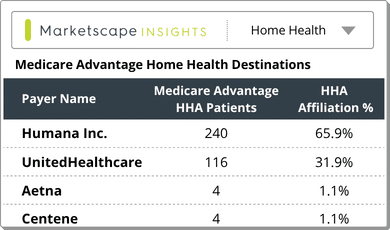BLOG
Referral Targeting Strategies Series: Underutilization
By: Teresa Buglione and Lauren Byers | October 21, 2020
For post-acute care organizations, growing and strengthening your referral network is the key to operational success. In our latest blog series, the Trella team will be diving into the most common, most effective, and most efficient targeting strategies you can use to improve your referral relationships and grow your post-acute care organization – through both admissions and revenue. The first three posts in our series cover the basic strategies every post-acute care organization should consider:
- Underutilization
- Under Affiliated
- Competitor Affiliated
These core strategies focus on identifying the right physicians to engage with to improve your referral partnership and overall patient outcomes. By demonstrating the value of post-acute care – and, more specifically, your organization’s strengths while highlighting your organization’s performance metrics – you can help ensure their patients get the right type of care at the right time.
Strategy 1: Underutilization
What it Means
Physicians who are underutilizing post-acute care have a large share of patients they’ve recently seen or treated who haven’t leveraged home health, hospice, or skilled nursing care, despite being eligible. While this sometimes happens because their patients aren’t adhering to instructions, many times it’s because patients have not been identified during the care cycle for these services
Based on the most recent claims data, only 50.6% of Medicare Fee-for-Service patients were discharged from an inpatient stay with post-acute care instructions nationwide. This opens the door for many post-acute care organizations to show how they can significantly improve patient outcomes, reduce Medicare costs, increase their admissions and revenue while lowering patient readmissions to inpatient stays.
Why it Matters
The lack of quality post-acute care for hospice patients can cause them undue pain and stress in their final stages of life. Hospitalization in a patient’s last 30 days of life or readmission to an inpatient stay, ER and observation visits increase Medicare costs while significantly impacting the patient’s overall quality of life.
Our recent Hospice End-of-Life Study showed that referring eligible patients to hospice care earlier will improve quality of life and increase comfort measures for patients and reduceby reducing ER and inpatient visits. Additionally, hospice care provides patients and their families with other benefits, including psychosocial and spiritual support for the family during this critical time.
For home health-eligible patients, receiving proper post-acute care can significantly improve patient outcomes, manage chronic conditions while reducing hospitalizations and inpatient readmissions. When prioritized and executed well, post-acute care can be an essential part of a patient’s recovery process. Identifying the physicians in your market who have patients that require post-acute care services is the first step towards that goal.
Key Metrics: Underutilization
When speaking with an underutilizing physician, it’s crucial to share how their home health or hospice utilization compares to their peers.
- Home Health: Look for physicians who are falling short of utilization averages for their specialty in their respective markets. If you are looking to increase post-acute service usage, digging deeper into their metrics will help you build a case. Are there certain diagnostic categories that show lower referral rates to home health? Find out why? Increasing referrals, in this case, maybe as simple as showing the benefits of home health to that specific diagnosis. If their competitors refer a significantly larger share of patients to home health, you can highlight the correlation to better patient outcomes and a lower total cost of care. For their patients who are utilizing home health, are they seeing improved outcomes? Ultimately, the metrics you use in building your data-driven conversation will vary based on the physician’s patients’ needs. But, from basic education on home health benefits to more complex comparative data, there are compelling metrics you can use to both find and persuade an underutilizing physician.
- Hospice: It’s essential to know where hospice-appropriate patients receive care during the last 30 days of life. As providers, the goal will always be to ensure comfort and quality of care during a patient’s final days – not only to the patient but also to their families. Patients who received no hospice care at all were ten times more likely to be readmitted to the hospital during the last month of life than those who received early hospice care. For any physician with lower than average utilization in their market, look for their hospice timing metrics – when did their patients enter hospice care? When exploring a physician’s patients in their last 30 days of life, try to find the following:
- What is the average length of stay for patients who received hospice care?
- What percentage of their patients started early hospice care early during their last 30 days?
- What percentage started late hospice in their last 30 days?
- What percentage of their patients received no hospice care at all?
- Once you understand their utilization breakout, see any correlations between hospice timing and ER or inpatient visits. When engaging with the physician, it’s helpful to show them the impact of identifying the need for hospice care sooner rather than later.
Speaking to Underutilization
Underutilization usually suggests that the physician is either unaware of home-based care options or is reluctant to suggest these services for their patients. Whether there is a lack of knowledge about the benefits or a reluctance to discuss sensitive care settings, particularly hospice, you’ll need to take an educational approach to help shift their mindset. Explain why it is important for physicians to take a proactive role in recommending the right post-acute care settings at the right times for their patients. Leveraging the right data to build the data-driven conversation can strengthen the case for post-acute care.
Present Your Case
An effective strategy to use with underutilizing physicians is to demonstrate the correlation between utilizing your care setting, patient outcomes, and cost of care. Here’s a sample presentation outline a hospice agency could use to guide their conversation:
- What is the challenge you’re trying to solve?
Improve quality of life during a critical time while reducing ER and inpatient visits by referring eligible patients to hospice earlier. - Why does this matter?
Late hospice patients were five times more likely to visit the emergency room during the last month of life than early hospice patients. This dramatically increases Medicare costs and reduces patient quality of life. - What are their metrics?
- How many end-of-life patients did they have in the most recent four reported quarters?
- How many of them had more than 30 days, fewer than 30 days, or no hospice care at all?
- What was the average amount of ER and inpatient visits during the last month of life for each of those groups?
- How did they compare to their peers?
- To the county and/or state averages?
- Do the math!
What kind of impact could they have by referring even half of their hospice-eligible patients to hospice care earlier? In a recent study, it was shown that early hospice intervention resulted in:- Six times lower healthcare costs
- Five times lower hospitalization rates
- Show your metrics
Now it’s your time to shine. Share how you stack up against the competition with ALOS, number of ER and inpatient visits, and number of visits during the last 3-7 days of life. Make your agency the obvious choice.
Next Steps
Helping physicians understand the value and benefits of using the right post-acute care setting at the right time for their patients is valuable – for your agency and the overall quality of care their patients receive. Using underutilization as a physician targeting method is an easy way to increase your referrals and admissions and make a meaningful difference in patients’ lives.
Trella Health customers have access to all the metrics we discussed in this article. For more information on how to use Marketscape to identify underutilizing physicians or to create sales collateral, contact your Customer Success Manager or request personalized training.
If you’re interested in learning more about how Marketscape from Trella Health can help you improve patient care and increase admissions with this and other targeting strategies, schedule your personalized demonstration today.
Stay tuned for the next installment of our targeting strategy series where we discuss unaffiliated physicians. And come back in early November to snag your copy of our Core Targeting Strategies Guide.















